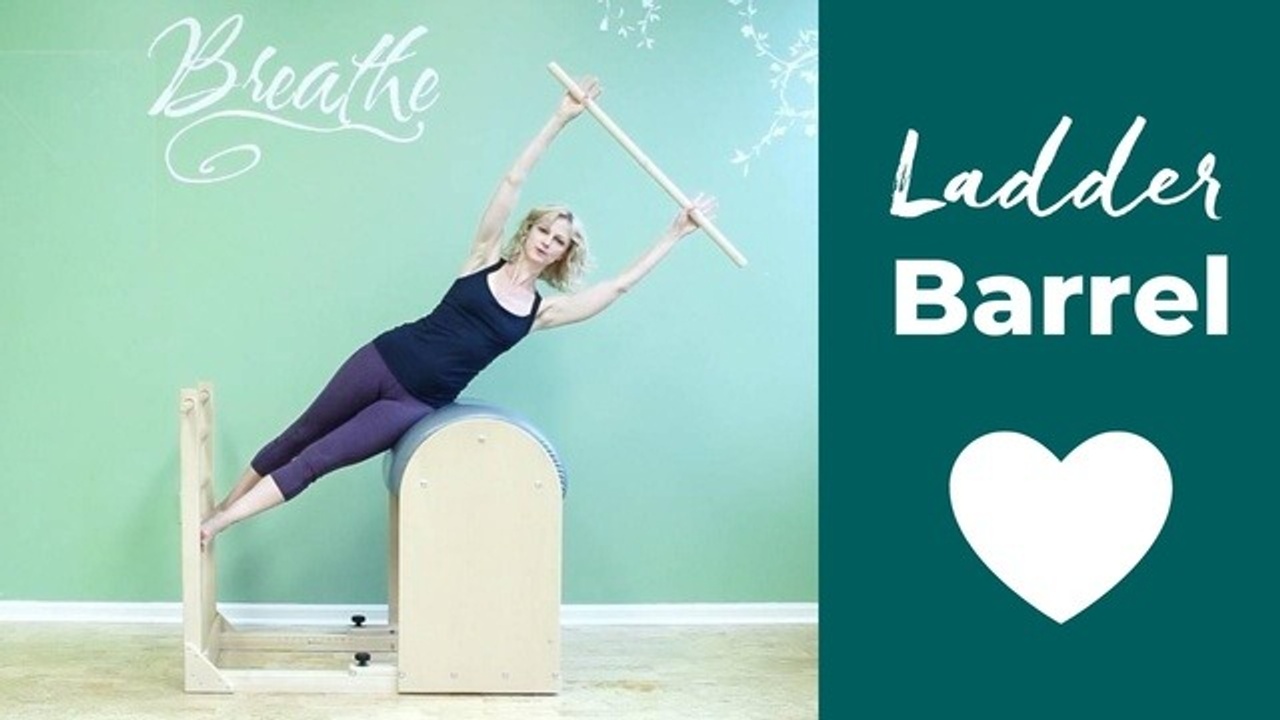An Ode to the Ladder Barrel
Oct 01, 2018
When have you last used the Ladder Barrel in your practice? Me? Yesterday. It’s one of my favorite pieces of equipment. (Shh, don’t tell the Reformer.)
If you haven’t played on the High Barrel in a while, let me tell you why you should hop on it in your next practice.
The large (Ladder Barrel or High Barrel) and small (Spine Corrector) barrels are the two pieces of Pilates equipment that don’t use springs. Maybe that’s why many teachers prefer the Trapeze Table, Chair, or Reformer. There is no doubt that working with springs is a unique feeling with incomparable benefits.
But the rounded shape of the barrels has something very special to offer, namely supported spinal movement. The human spine is, as you know, not stick straight. It comes with 5 curves: Starting at the bottom tip of the spine, the coccyx (tailbone) curves inward (concave), one step higher between the two halves (innominate bones) of the pelvis, there is the outwardly curved shape of the sacrum, then follow lumbar lordosis, thoracic kyphosis, and cervical lordosis.
Related: How To Adjust the Ladder Barrel
Working on a flat surface like the Reformer carriage or Trapeze Table the two different shapes are fighting a bit with each other. Who hasn’t at one point wanted to flatten their lumbar spine to the table. It feels so nicely supported. But no, don’t do that, warns your teachers. Keep your “neutral spine”. But neutral sometimes doesn’t feel natural.
As a result, we have to put all our focus on maintaining our natural (shmatural) curves the way they should be, regardless of the flat rigid surface they’re on.
Not on the Barrel. No! We can melt our curved spine around the curves of the barrel. Now if all that talk about curves is not a great way to get more men into Pilates, then I don’t know what is.
Note: You'll find links to the exercises I'm mentioning in this post at the bottom of this page. 👇
I’m thinking about Standing Back Bend, Short Box Round Back, Climb a Tree, Bridging, and Side Over.
Another aspect I value about the High Barrel is the ease of use. No springs mean a less complicated setup. If you (allow your students to) practice independently or you teach (or take) Duets or Trios, it’s tremendously helpful to have one person stretch their leg and hip muscles with the Ballet Stretches, freeing up the teacher’s focus to work a bit more closely with the other person.
Using the Barrel is less scary for a beginner of Pilates because there are fewer moving parts, no springs and clips, ropes, and eye bolts to worry about. What you see is what you get, sort of. No unexpected loss of control and flying pedals.
Some older Pilates practitioners (possibly with knee pain) have trouble getting up and down from the floor, but standing next to the Ladder Barrel, leaning against it, or sitting on it, is more accessible to them. This turns into more options, more exercises, less time spent on setting up the machine and getting into the starting position.
One thing that might have caused you to ignore the Ladder Barrel in the past, is that the repertoire is undoubtedly smaller than on most other pieces. I’m thrilled to see that the number of exercises one can do increases every year thanks to some creative and inventive teachers.
But let me tell you, the exercises you CAN do are fabulous. I mean there is no comparison. No other exercise on another piece of apparatus does what the Standing Back Bend does in terms of eccentric core control to improve posture.
There is nothing quite like Short Box Flat Back or Oblique Flat Back. Not even the same exercise on the Reformer. The way the back of the pelvis gets feedback from the barrel. The way the feet can actively press against the rung of the ladder, giving the glutes a chance to help with hip extension.
If you own a studio and don’t (yet) own a Ladder Barrel because you’re worried that it won’t give you enough bang for your buck, think again. Especially, if you own a small boutique studio with one piece of each major apparatus. The High Barrel doesn’t take up much floor space and the fact that you can confidently let a student practice independently on it, makes your teaching life so much easier.
I use the Ladder Barrel every time I practice, and almost all of my students have a few exercises that build core strength like nothing else. I hear my student Christine “complaining” how the Side Sit Up just doesn’t get any easier, even after practicing it consistently for a year. Doesn’t that show you what a valuable exercise it is. It gives and gives and gives.
The Ladder Barrel offers some of the most beneficial and accessible abdominal exercises in the whole Pilates Method.
- Back to Forward Bend
- Bridging
- Dart
- Grasshopper
- Horseback
- Lay Backs
- Leg Series
- Leg Stretches (aka Ballet Stretches):
- Adductors
- Figure 4
- Hamstrings
- Thighs
- Roll Over Shoulderstand
- Short Box: Round Back/ C-Curve/ Roll Down
- Short Box Series: Flat Back Hinge
- Short Box Series: Oblique Flat Back/ Oblique Hinge
- Short Box: Climb a Tree
- Short Box Series: Twist
- Shoulderstand
- Side Dangling
- Side Hanging
- Side Over
- Side Sit Up Advanced
- Side Sit Up Basic
- Standing Back Bend
- Supine Leg Series
- Supine Stretch
- Swan
- Swimming
- Thigh Stretch
Learn all of these exercises in detail
inside the Pilates Encyclopedia membership.
Learn more...









